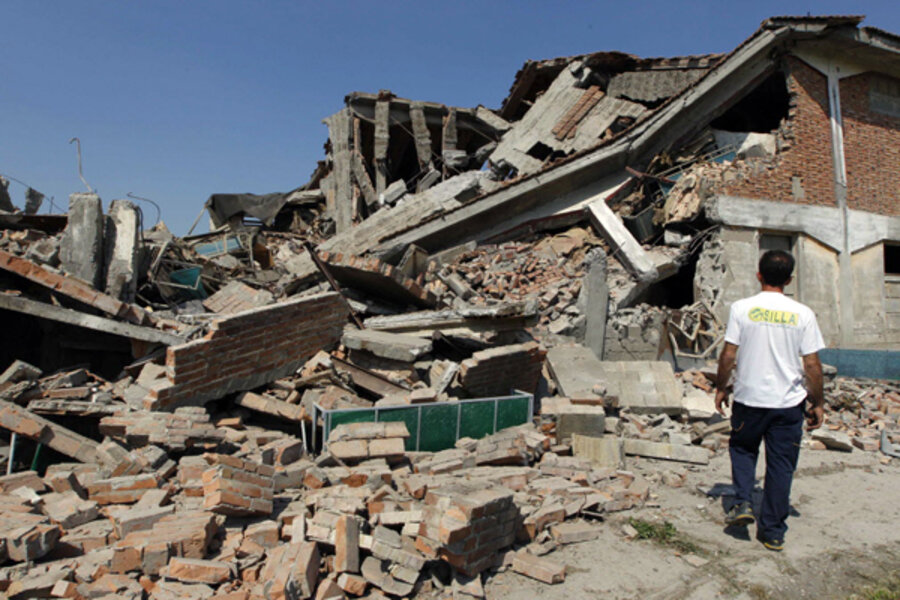Powerful Italy quake leaves at least 15 dead
Loading...
| MIRANDOLA, Italy
A powerful earthquake killed at least 15 people as it rocked a swath of northernItaly on Tuesday. Factories and churches collapsed, dealing another blow to a region where thousands are still homeless after a stronger quake just nine days ago.
The 5.8 magnitude quake added to the misery being felt in the Emilia Romagna region of towns north of Bologna, one of Italy's most agriculturally and industrial protective areas.
The quake hit just after 9:00 a.m. with an epicenter 40 kilometers (25 miles) northwest of Bologna, according to the U.S. Geological Survey — just a handful of (miles) kilometers away from where the deadly May 20 quake was centered.
The quake was felt from Piedmont in northwestern Italy to Venice in the northeast and as far north as Austria. It was followed by many aftershocks, some registering more than 5.0 in magnitude.
While Tuesday's quake was about 100 times less intense than the 6.0 temblor on May 20, its death toll was more than twice the earlier quake's toll of seven. In both, the dead included workers killed by collapsing factories and warehouses.
Civil Protection agency officials said at least 15 people were killed, about 100 were injured and there was no precise number of the missing. Emergency crews were trying to sift through the twisted steel and broken stone, looking for victims.
In the town of Mirandola, near the epicenter, the church of San Francis crumbled, leaving only its facade standing. The main cathedral also collapsed.
The 9 a.m. temblor terrified many of the thousands of residents who have been living in tents or cars since the May 20 quake and added thousands more homeless into the area.
"I was shaving and I ran out very fast, half dressed," a resident of Sant'Agostino, one of the towns devastated in the quake earlier this month, told AP Television News on Tuesday.
Sant'Agostino's town hall, so damaged in the May 20 quake that it looked as if it had been bombed, virtually collapsed when the latest deadly temblor struck.
In a hastily called news conference, Premier Mario Monti pledged the government will do "all that it must and all that is possible in the briefest period to guarantee the resumption of normal life in this area that is so special, so important and so productive for Italy."
The region around Bologna is among the country's most productive. Italy is desperately in need of its industries, for the country is in the midst of another recession and struggling to tame its massive debt as the European debt crisis worsens.
Many victims of the new quake, like the one nine days ago, were at work in huge warehouses that collapsed, including one dead inside a machinery factory in Mirandola.
The mayor of San Felice sul Panaro told Sky News 24 that there were fatalities in his town, where Italian media said a tower had collapsed.
Tall buildings and schools were evacuated as far away as Milan as a precaution before people were allowed to re-enter. Train lines connecting Bologna with other northern cities were halted while authorities checked for any damage.
When the quake hit, Monti was meeting with emergency officials in Rome to discuss the impact of the earlier quake, which struck in the middle of the night and left at least 7,000 homeless.
The May 20 quake was described by Italian emergency officials as the worst to hit the region since the 1300s. In addition to the deaths, it knocked down a clock tower and other centuries-old buildings and caused millions in losses to a region known for making Parmesan cheese. Its epicenter was about 35 kilometers (22 miles) north of Bologna.
Residents had just been taking tentative steps toward resuming normal life when the second quake struck. In the town of Sant'Agostino, a daycare center had just reopened.
In the town of Concordia, the mayor had scheduled a town meeting Tuesday evening to discuss the aftermath of the first quake. Instead, mayor Carlo Marchini confirmed the death of one person struck by falling debris in the town's historic center.
Italy's friendly soccer match against Luxembourg, a warm-up match for the Euro 2012 championships, was canceled. The game was due to be played Tuesday in Parma, just 40 miles (60 kilometers) west of the quake.





